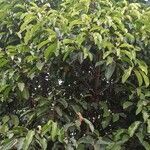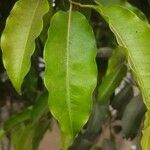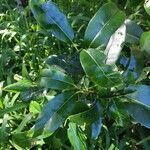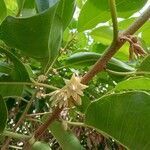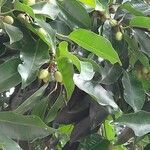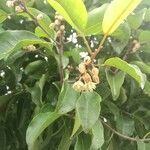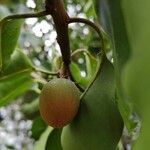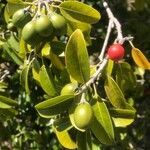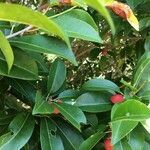| Therapeutic use
|
Immunostimulant (bark), Amnesia (bark), Analgesics (bark), Anthelmintics (bark), Anti-bacterial agents (bark), Antifungal agents (bark), Antioxidants (bark), Antipyretics (bark), Anxiety disorders (bark), Appetite stimulants (bark), Astringents (bark), Burns (bark), Cardiotonic agents (bark), Cicatrix (bark), Dental caries (bark), Diabetes mellitus (bark), Diarrhea (bark), Dysentery (bark), Ear diseases (bark), Fertility agents, female (bark), Fever (bark), Gingival hemorrhage (bark), Gingivitis (bark), Infertility, female (bark), Insecticides (bark), Leprosy (bark), Molluscacides (bark), Pain (bark), Periodontal diseases (bark), Periodontitis (bark), Pharyngitis (bark), General tonic for rejuvenation (bark), Salivation (bark), Scabies (bark), Snake bites (bark), Stomatitis (bark), Tooth diseases (bark), Toothbrush (bark), Ulcer (bark), Urolithiasis (bark), Uterine diseases (bark), Vomiting (bark), Wounds and injuries (bark), Urethral diseases (bark), Cooling effect on body (bark), Hair loss (flower), Amnesia (flower), Analgesics (flower), Anti-bacterial agents (flower), Antidiuretic agents (flower), Antioxidants (flower), Antipyretics (flower), Antitoxins (flower), Antitussive agents (flower), Astringents (flower), Brain diseases (flower), Bronchitis (flower), Diarrhea (flower), Dysentery (flower), Fractures, bone (flower), Furunculosis (flower), Headache (flower), Heart diseases (flower), Laxatives (flower), Mental disorders (flower), Narcotics (flower), Nasal disease (flower), Pain (flower), Periodontal diseases (flower), Pharyngitis (flower), Polyuria (flower), General tonic for rejuvenation (flower), Skin diseases (flower), Snake bites (flower), Tooth diseases (flower), Ulcer (flower), Wound healing (flower), Wounds and injuries (flower), Urethral diseases (flower), Constipation (seed), Cooling effect on body (flower), Analgesics (fruit), Anthelmintics (fruit), Anti-bacterial agents (fruit), Antidiuretic agents (fruit), Antifungal agents (fruit), Antioxidants (fruit), Antipyretics (fruit), Antitussive agents (fruit), Aphrodisiacs (fruit), Astringents (fruit), Blood pressure regulation (fruit), Brain diseases (fruit), Convalescence (fruit), Dental caries (fruit), Diarrhea (fruit), Diuretics (fruit), Dysentery (fruit), Fertility agents (fruit), Flatulence (fruit), Headache (fruit), Heart diseases (fruit), Hematologic diseases (fruit), Laxatives (fruit), Pain (fruit), Parasympatholytics (fruit), Periodontal diseases (fruit), Periodontitis (fruit), Pregnancy complications (fruit), General tonic for rejuvenation (fruit), Tooth diseases (fruit), Tooth mobility (fruit), Ulcer (fruit), Wound healing (fruit), Wounds and injuries (fruit), Urethral diseases (fruit), Cooling effect on body (fruit), Analgesics (leaf), Anthelmintics (leaf), Anti-bacterial agents (leaf), Antidotes (leaf), Antifungal agents (leaf), Anti-infective agents (leaf), Anti-inflammatory agents (leaf), Antineoplastic agents (leaf), Antioxidants (leaf), Antitussive agents (leaf), Appetite stimulants (leaf), Astringents (leaf), Cardiotonic agents (leaf), Common cold (leaf), Dental caries (leaf), Diabetes mellitus (leaf), Diarrhea (leaf), Headache (leaf), Periodontal diseases (leaf), Periodontitis (leaf), Pruritus (leaf), Snake bites (leaf), Tooth diseases (leaf), Toothbrush (leaf), Urticaria (leaf), Fever (plant exudate), Mouthwashes (plant exudate), Oral ulcer (plant exudate), Periodontitis (plant exudate), General tonic for rejuvenation (plant exudate), Stomatitis (plant exudate), Antidiuretic agents (root), Aphrodisiacs (root), Periodontal diseases (root), Anemia, hemolytic (seed), Anti-bacterial agents (seed), Antidiuretic agents (seed), Anti-inflammatory agents (seed), Aphrodisiacs (seed), Astringents (seed), Cardiovascular agents (seed), Cardiovascular diseases (seed), Cathartics (seed), Diarrhea (seed), Diet, food, and nutrition (seed), Diuretics (seed), Hemorrhoids (seed), Laxatives (seed), Parasympatholytics (seed), Polyuria (seed), Premature ejaculation (seed), Spermatocidal agents (seed), Antipyretics (shoot), Astringents (shoot), Dental caries (shoot), Wound healing (shoot), Analgesics (stem), Dental caries (stem), Diarrhea (stem), Diuretics (stem), Dysentery (stem), Gonorrhea (stem), Urinary tract infections (stem), Wound healing (stem), Urethral discharge (stem), Astringent (unspecified), Bite(Tiger) (unspecified), Bronchitis (unspecified), Carbuncle (unspecified), Tuberculosis (unspecified), Cosmetic (unspecified), Cough (unspecified), Dermatosis (unspecified), Diarrhea (unspecified), Dropsy (unspecified), Dysentery (unspecified), Fever (unspecified), Headache (unspecified), Laxative (unspecified), Leukorrhea (unspecified), Ophthalmia (unspecified), Pimple (unspecified), Poison (unspecified), Purgative (unspecified), Pyorrhea (unspecified), Restorative (unspecified), Rhinosis (unspecified), Smallpox (unspecified), Snuff (unspecified), Sprue (unspecified), Stimulant (unspecified), Stomatosis (unspecified), Tongue (unspecified), Tonic (unspecified), Tumor (unspecified), Anasarca (unspecified), Anodyne (unspecified), Dentifrice (unspecified), Gargle (unspecified), Glossitis (unspecified), Menorrhagia (unspecified), Sore (unspecified), Sore(Throat) (unspecified), Syphilis (unspecified), Thrush (unspecified), Gingivitis (unspecified), Gonorrhea (unspecified), Analgesics (unspecified), Anti-bacterial agents (unspecified), Antipyretics (unspecified), Antitussive agents (unspecified), Constipation (unspecified), Convalescence (unspecified), Diuretics (unspecified), Edema (unspecified), Eye infections (unspecified), Fertility agents, female (unspecified), Oral ulcer (unspecified), Periodontal diseases (unspecified), Snake bites (unspecified), Tooth diseases (unspecified), Wounds and injuries (unspecified), Mycotoxicosis (whole plant)
|
